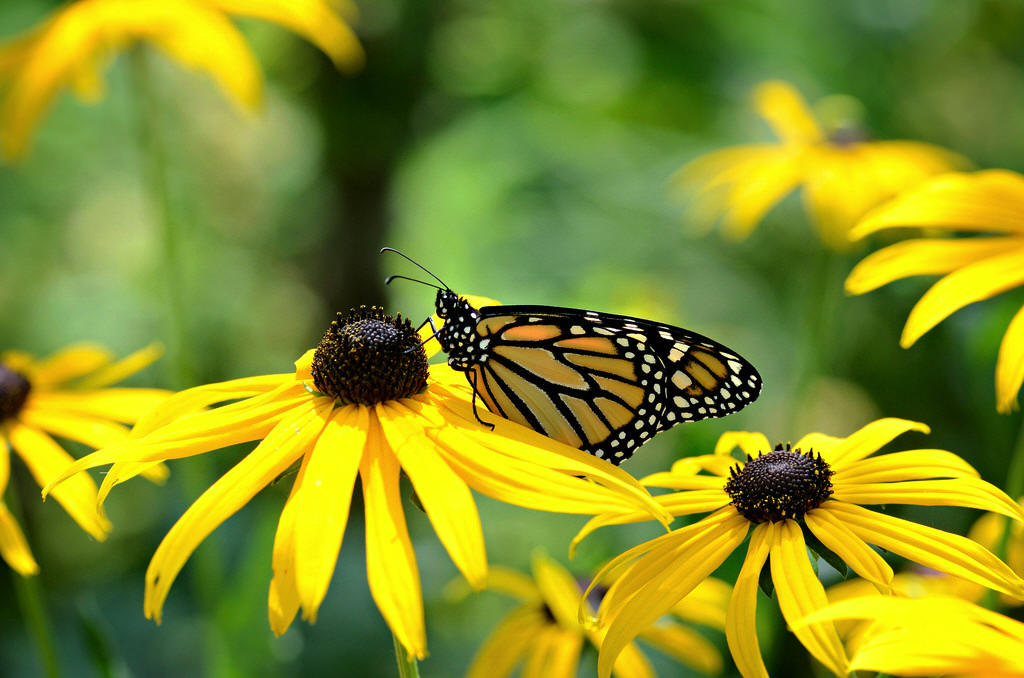 (9/21) If you read this column regularly, or even if you glance at it occasionally, you have a love of nature, and you probably know about the plight of the monarch butterfly (Danaus plexippus L.). Yes, its population is dwindling to dangerously low levels. There
are several reasons that this charismatic butterfly is in danger of extinction, and knowing the reasons can give us chance to see how we can help reverse the trend.
(9/21) If you read this column regularly, or even if you glance at it occasionally, you have a love of nature, and you probably know about the plight of the monarch butterfly (Danaus plexippus L.). Yes, its population is dwindling to dangerously low levels. There
are several reasons that this charismatic butterfly is in danger of extinction, and knowing the reasons can give us chance to see how we can help reverse the trend.
The unusual life cycle of the monarchs includes an overwintering segment in which the adults are not reproductively active. Once they finished their fall migration to a small area of mountainous fir forests in south central Mexico, they enter a resting state. They cluster tightly on the trunks and branches of the trees, and use as little energy as
possible during the winter months. They are at risk here because illegal logging is destroying this overwintering habitat, special to them for its unique microclimate.
As day length increases and the sun moves north in the sky, the adults with adequate energy reserves mate. Females lay their eggs after they have traveled north again, when they reach areas with adequate populations of milkweeds, their host plant, the only plants that can nurture monarch larvae. It's the grandchildren of this first generation back
from Mexico - four generations! -that will again make the migration back to Mexico. (Notice that species which have special environmental features in their life cycles are usually the ones endangered; generalist species do quite well within a human-altered environment.)
Once they migrate north into the US and Canada, monarchs face dangers from lack of milkweed. There are several species of milkweed which support monarch caterpillars, including the weedy-looking common milkweed (Asclepias syriaca, L.) and the iconic orange butterfly weed (A. tuberosa). These grow in open, disturbed habitats, and a likely place to
find this type of habitat is at the edges of farm fields. Unfortunately, the use of herbicides on farm fields often impacts these edges and eliminates the hosts of the monarch, as well as the weeds in the fields
We can help the monarchs at this point if we have space for a garden - a butterfly garden - to provide a place for monarchs to thrive. We will also be rewarded with the opportunity to watch the entire life cycle play out before us. The eggs laid on milkweed hatch to become the caterpillars we watch feed. The caterpillars grow until they turn
themselves into a 'J' as they hang from a leaf. They encase themselves in a chrysalis, finally emerging as an adult. I know gardeners who sequester their caterpillars just before they are ready to pupate (that is, become a chrysalis) to keep them out of harm's way, and of course, to enjoy watching the process.
As important as milkweed is for caterpillars, the adults rely on nectar for food, especially as they get ready for their migration. The monarchs need to bulk up for two reasons. The flight to Mexico is grueling, even though they try to make most of the trip soaring on favorable winds, reducing their need to burn their fat reserves. Along the way,
they often roost, resting and feeding, when weather for traveling is unfavorable. Once in their fir forests in Mexico, the butterflies with adequate fat reserves are able to survive the winter better and are more reproductively fit.
A butterfly garden also helps the monarchs along their migration. Besides milkweeds, these gardens have nectar-producing plants for the adults, the best belonging to the aster family. There are several perennial species of this family that we associate with pollinators - for instance, Black-eyed Susan (Rudbeckia), cone flower (Echinacea), and Aster
(Symphyotrichum). Also, consider annuals of this group, such as Zinnias and Mexican sunflower (Tithonia), that persist all summer and into the fall, providing a steady nectar supply.
Will the monarch butterfly disappear completely if their forest is lost? Perhaps not! Of course, we want to keep the migrating monarchs we love gracing our gardens every summer and fall, but there are non-migrating populations in Florida and on the Gulf coast, as well as west coast monarchs that overwinter in California. The Gulf monarchs are
year-round residents and show some genetic differences from migration populations, but they are still considered members of the same species we love to see grace our gardens here.
Read other articles on birds, wildlife & beneficial insects